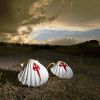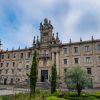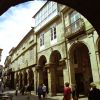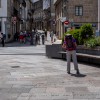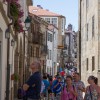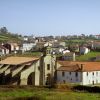- Accede I
- Regístrate I
- carrito
01. Introducción
01. Introducción

Han pasado ya casi 2000 años de la muerte de Cristo. Sus doce apóstoles se dispersaron por el mundo para predicar su palabra. Pedro marchó a Roma, Mateo a Judea, Santiago El Mayor, hijo de Zebedeo y de María Salomé, hermano de Juan Evangelista y considerado como primo de Jesucristo, es quien marcha a Hispania. De acuerdo con la tradición, su cometido será difundir los evangelios por el lejano Finis Terrae, el fin del mundo entonces conocido. Pero a su regreso a Jerusalén, Santiago es apresado y decapitado por Herodes Agripa en el año 41, convirtiéndose en el primer apóstol martirizado.
Dice la leyenda que el cuerpo ya sin vida de Santiago fue conducido hasta Galicia por dos de sus jóvenes discípulos. A bordo de una barca de piedra escoltada por ángeles, emprenden un viaje milagroso atravesando el Mar Mediterráneo, hasta que finalmente alcanzan el puerto romano de Iria Flavia, en la lejana provincia de Gallaecia. Un recóndito lugar junto al monte llamado Liberum Donum será el lugar elegido para dar sepultura al Apóstol.
Durante un largo tiempo se perdió el rastro de su tumba. 800 años más tarde, continúa la leyenda, un ermitaño avistó luces celestiales que lo condujeron hacia el lugar sagrado, descubriendo el sepulcro del santo.
El rey Alfonso II hizo construir en su nombre una pequeña iglesia, pero es Alfonso III, en el siglo IX, quien lo nombra patrono de todo su reino y quien encarga la construcción de una basílica digna del acontecimiento que comenzaba a movilizar a miles de fieles de toda Europa.
El resplandor de esas luces que señalaban la ubicación de su sepultura, haría llamar al lugar Campus Stellae, Campo de Estrellas, Compostela.
En el siglo XII, el Papa Calixto II decide que todo aquel que visite la Catedral de Santiago durante el Año Santo, obtendrá las mismas indulgencias que los que acudan a Roma en los años jubilares. Es Año Santo Compostelano o Jacobeo, cuando el 25 de julio, fiesta del martirio de Santiago, cae en domingo. De esta manera, el jubileo compostelano se celebra con una cadencia de 6, 5, 6, y 11 años.
Desde entonces, el peregrino puede alcanzar la indulgencia en Año Santo, a partir del día 1 de enero y hasta el 31 de diciembre, si cumple ciertos ritos piadosos: visitar la catedral y el sepulcro del apóstol, rezar una oración, confesarse y comulgar.
Por este motivo, miles de peregrinos comenzaron a recorrer las sendas del Camino de Santiago. Casi todos iban movidos por la fe, por la búsqueda de la salvación y el deseo de llegar hasta la tumba apostólica, pero algunos también en cumplimiento de una pena impuesta e incluso peregrinando en el nombre de alguien por dinero. Los distinguía el mismo atuendo: bastón, calabaza para el agua y la vieira o concha. Esta acabó convirtiéndose en una señal protectora, ya que aquel que robara a un peregrino era acusado de un gran delito y lo pagaba incluso con la muerte.
Para atender a los caminantes surgieron monasterios, iglesias, hospitales, refugios, puentes y calzadas. Allí donde confluían los peregrinos acababan naciendo pequeñas urbes que daban lugar a pueblos y ciudades que forman parte de una de las rutas más importantes de la fe cristiana.










